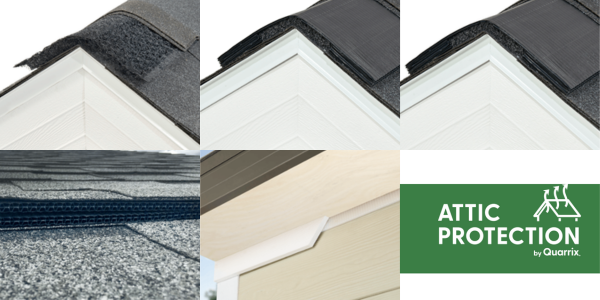6 attic ventilation solutions for enhanced roof performance

By Jessica Bravo.
Exploring quality ventilation products that support the longevity of your attic.
In this episode of Roofing Road Trips®, Heidi J. Ellsworth had the opportunity to speak with Mark Huysken from Quarrix Building Products about the importance of proper ventilation and the differences between various ventilation systems. With over two decades of experience in the roofing industry, Mark shared valuable insights on this topic.
Addressing ventilation effectively is becoming increasingly important. When homes are tightly sealed, exterior products that once benefited from natural airflow may struggle. This lack of ventilation can lead to trapped moisture in the attic, causing a range of problems.
Mark emphasized the need for a balanced ventilation system, sharing, “I'm spending a lot of my ventilation trainings now talking about that, how to assess that situation and how to balance it. Because without balance, the system fails miserably.” His training sessions focus on conducting ventilation audits, analyzing exhaust needs and ensuring a balanced system for optimal performance.
He also highlighted that proper ventilation is crucial for maintaining the longevity of roofing materials. Even high-quality lifetime shingles won’t perform as intended without adequate ventilation. When selecting ventilation products, it’s essential to choose one that is designed to optimize home performance and protect roofing systems. Quarrix offers a comprehensive range of ventilation products. Here’s a breakdown of the different types of vents they provide:
1 - Ridge vents
Ridge vents are installed along the peak of the roof and provide continuous, low-profile ventilation. They help exhaust hot, humid air from the attic, promoting better air circulation and preventing moisture buildup.
2 - Soffit vents
Soffit vents are placed under the eaves of the roof and work with ridge vents to allow fresh, cooler air into the attic space. This balanced airflow improves overall ventilation.
3 - Gable vents
Gable vents are located at the gable ends of the roof and provide an additional outlet for hot air and moisture to escape from the attic. They are often used in combination with other ventilation systems to enhance airflow.
4 - Roof vents
Roof vents, available in various styles including static and powered options, are installed on the roof surface to release excess heat and moisture from the attic, ensuring a well-ventilated space.
5 - Eave vents
Eave vents are installed along the eaves of the roof, similar to soffit vents and help ensure adequate airflow throughout the attic when used with other ventilation solutions.
6 - Turbine vents
Turbine vents are roof-mounted and use a spinning mechanism to enhance ventilation. As the turbines spin, they create a suction effect that helps expel hot air and moisture from the attic more efficiently.
Read the transcript or Listen to the entire episode to learn more about the importance of proper ventilation.
Learn more about Quarrix in their Coffee Shop Directory or visit www.quarrix.com.
About Jessica
Jessica is the Spanish content creator at The Coffee Shops and a senior at the University of Houston, studying psychology. A proud Mexican-American, she enjoys running trails and exploring Houston in her free time.






















Comments
Leave a Reply
Have an account? Login to leave a comment!
Sign In